[ad_1]
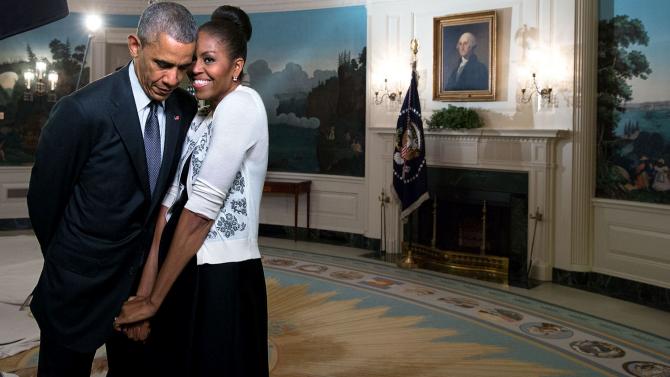
The first lady snuggled against the president during a videotaping for the 2015 World Expo in the Diplomatic Reception Room of the White House March 27, 2015.
Amanda Lucidon/White House
How apropos that first lady Michelle Obama’s Secret Service code sums up her life and persona perfectly. She is indeed a Renaissance woman in that she is accomplished, refined, has far-ranging talents and seemingly does it all: (working) mother, loving wife, dutiful daughter. Twice Ivy League-educated lawyer, slayer of fashion all day every day, genuine, down to earth, accessible, determined, compassionate, opener of the White House, and a solitary black woman essentially holding the country down because she is holding our commander in chief down.
In the time that President Barack Obama has been in office, Michelle Obama has maintained an overall likability rating of over 70 percent (even when her husband’s has slipped under 40)—their favorability in the stratosphere, of course, for black folk. Like her husband, who rode into office in 2008 as our sepia-toned working-class version of Camelot, Michelle Obama can do no wrong.
In the fourth installment of His Lasting Legacy, a look back over this final year of the Obama administration, we turn away for a bit from the president and take a closer look at his wife. We spoke to two authors who penned books on Michelle Obama, and who have covered the first lady and her husband’s historic rise to the highest office in the land. Both have seen Michelle Obama up close and personal and witnessed her evolution from a working mother of two young girls in the Midwest to the lady of 1600 Pennsylvania Ave.
Allison Samuels, author of the 2013 tome on the first lady, What Would Michelle Do?: A Modern-Day Guide to Living With Substance and Style, offers that perhaps Michelle Obama’s greatest gift is about her ability to “pull back” yet still manage to maintain her sense of self.
“With Michelle, you see that there’s more there than she’s showing,” says Samuels. “You can see she’s charming and talented and smart. Just as smart as [President Obama] is. I think she understood how to pull back just enough without losing too much of herself. In our lifetime, to see how you balance all those things as a woman, and support your man, and support your children, and take care of your mother. She’s doing it all. … And looks fashionable doing it. I don’t know if I’ve ever seen that done so well in such a public space.”
For biographer Peter Slevin, author of the 2015 PEN award-nominated biography, Michelle Obama: A Life, the first lady is the most intentional of all the first ladies in that she went in knowing exactly what she wanted to do, and then executed.
“She was much more purposeful and much more methodical in developing her agenda then we’re accustomed to seeing,” says Slevin. “All first ladies have had significant projects to which they attached their name, yet she was more ambitious in doing meaningful work than her modern predecessors. She was more determined to make a difference in more disciplined and creative ways, and she’s really determined to make a difference.”
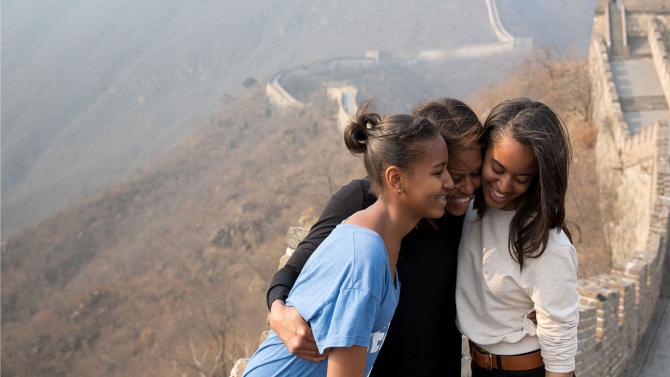
First lady Michelle Obama hugs daughters Sasha (left) and Malia as they visit the Great Wall of China in Mutianyu, China, March 23, 2014.
Amanda Lucidon/White House
From the very beginning of the Obama administration, Michelle Obama made a decision to put family first. She brought her mother, Marian Robinson, into the White House, and made sure her daughters remained as humble and as normal as one can be while living in the bubble that is the White House.
She also remains the president’s “true north.”
“Michelle Obama always says what she thinks. That the president can rely on her to tell him what’s going on,” explains Slevin. “Valerie Jarrett said she doesn’t sugarcoat her perspective, or dance around the issues; she calls it like she sees it. Although, she chooses her moments.”
“She understood exactly what she was going to do the moment he won the election. That she was going to be first mom in charge, which is what she said, and she was going to support [the president],” says Samuels. “She understood any missteps that she made was going to impact him more so than any other first lady. She was very clear on what her boundaries needed to be, and she has stayed true to them this whole time.”
There was some critique from traditionally white, upper-middle-class feminist corners (summarily dismissed by some) when this Ivy League-educated lawyer announced that her first priority as first lady would be providing a safe space for her daughters by working three days a week and holding her husband down from behind the scenes. In the face of these criticisms, Michelle Obama kept it moving.
“Feminists said, ‘Mom-in-chief. Are you kidding me? This woman who went to Princeton and Harvard Law, and she had a 20-year career, and she’s talking about being mom in chief?’ But like seemingly all things that she considers, Michelle Obama brought her own interpretation of feminism to the equation, including the right to own your own choices. And she is making them,” says Slevin. “A very considered, kind of, smorgasbord of choices.”
“I think she’s this woman who’s very focused and clear on what’s important in life,” says Samuels. “That sounds cliché, but it really isn’t. Particularly not in that world, where you can get taken off track so easily. She’s focused.”
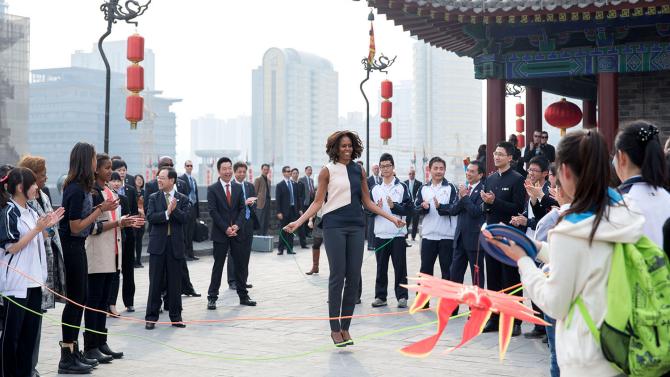
First lady Michelle Obama, accompanied by daughters, Sasha and Malia, and mother, Marian Robinson, jumps rope as children demonstrate games during a visit to the City Wall in Xi’an, China, March 24, 2014.
Amanda Lucidon/White House
In a dark sea of reality TV where black women literally tear into each other on a regular basis, Michelle Obama travels the world representing the United States (and black women) with panache. She is a walking billboard of sophistication, culture, warmth—the antithesis of what the dominant narrative is for us. But she is no exception—she is one of us.
“I’ve watched her grow into this fashionista. This very beautiful, smart, intelligent, woman who also cares about what’s on the fashion runway every year. Or every week, or whatever,” says Samuels.
She continues: “I think she’s incredibly striking and attractive, but what I love is that she still has that confidence. She still has that attitude of, ‘I’m all that, and you should know it.’ She’s able to present that without it being too much, or being off-putting. You see a woman who’s very confident in who she is and what she has to offer. I just think our young girls need that so much. And I hope they’re taking notes.”
Grande Dame of the Delicate Dance
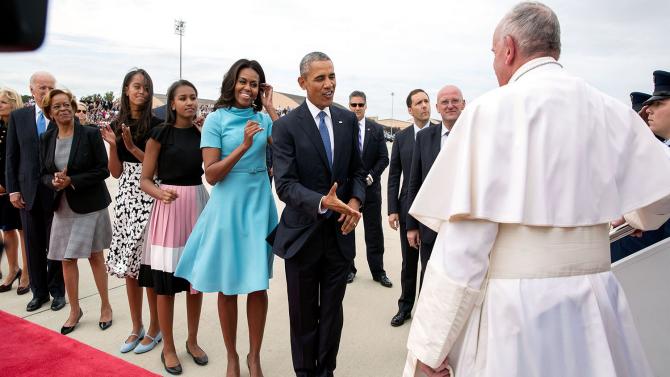
The Obama family and the Biden family greet Pope Francis as he arrives in the United States for the first time at Joint Base Andrews Sept. 22, 2015.
Pete Souza/White House
Early on in the Obama presidency, Michelle Obama was accused of being angry and aggressive, a notion far too many black women are painted with for just expressing their opinions or being passionate, or maybe because every thing that we do is racialized into stereotype.
From the fist bump that became her very first magazine cover to (an incorrectly reported) 2013 story that she was mad that President Obama was taking selfies with the Dutch prime minister, Michelle Obama has weathered the angry black woman stereotype with aplomb.
But more than that, she has become mistress of the delicate dance between what she wants and getting what she wants by being smart and strategic.
“She has been vocal in a nonvocal way,” says Samuels. “In terms of bringing African-American interests to the forefront via the White House, and being so sleek about it. I didn’t say slick, I said sleek. Very polished. You didn’t hear criticism. Nothing. Because she did it in a way where it didn’t ruffle feathers, but I think we, as African Americans, saw very clearly the point she was making.”
Like her husband, and the timbre of his legacy, Michelle Obama’s blackness—so obvious, so beloved, so essential—has not been dominant, but it’s still there. And the way she approached it has been masterful.
One only has to look at her actions, including her community service projects as first lady, including the Let’s Move!, Joining Forces or Reach Higher campaigns. Which communities are disproportionately impacted by childhood obesity and food deserts? Overindexed in the military? Or are first-generation college students?
“That delicate dance she’s had to do for eight years, that is perfection,” says Samuels. “That is grace and I’m in awe of her. She’s not made a misstep.”
Indeed, there has been nary a scandal in the Obama White House. Moreover, in an age of social media, Michelle Obama does not have to rely on middlemen (the press) to get her carefully crafted dispatches out. This is a woman who controls her message, and she controls her brand.
“She has figured a way to target the audiences she most cares about in a way that none of her predecessors were able to do,” says Slevin. “She has found a way to deliver her message in a largely unfiltered way by going straight to her audiences, and by going to the places where her audiences live. She’s using every tool of social media yet invented, and she seems to be using new ones every month.”
Legacy? She’s Just Getting Started
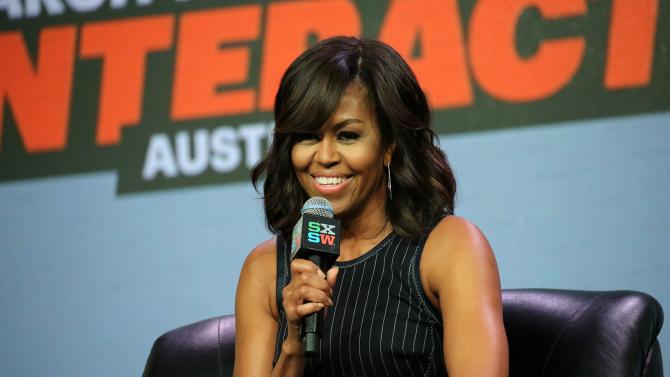
First lady Michelle Obama speaks onstage March 16, 2016, as a keynote speaker during the 2016 SXSW Music, Film + Interactive Festival at the Austin Convention Center in Austin, Texas.
Neilson Barnard/Getty Images for SXSW
Although Michelle Obama herself has allegedly said to friends that she’s “had her bags packed” by the door, and wants to drive after leaving the White House, it is clear that her legacy is yet to be determined. Her life in the White House, though it comes with resources, has been quite prescribed. It is clear that she is not even shown us the extent of what she will do to leverage the access of these eight years. And she’s said as much.
“Sometimes there’s much more you can do outside the White House without the constraints, the lights and the cameras, and the partisanship,” Obama said at her keynote panel at last week’s 2016 SXSW conference. “There’s a potential that my voice can be heard by people who can’t hear me now because I’m Michelle Obama, the first lady.”
And then, most tellingly, “We’re not through yet, there is a lifetime after the White House.”
It’s obvious Michelle Obama is looking at the long game—whether it deals with childhood obesity and healthy eating, or any number of other issues that plague American children.
“Whatever the legacy will be, it will be determined by her and no one else. She’s clear about who she is and what she wants to be remembered for,” says Samuels.
“I think she will be much more vocal because now she can, about the things that she finds important to her,” Samuel adds. “I think she will be on the forefront of all those things. The Chicago murders, all that. I see her being out there, and enjoying that part, because no one’s going to say anything.”
Also in the His Lasting Legacy series on The Root:
“Historic Presidency, Historic Opposition: The Legacy of President Barack Obama”
“Fighting Racism in the Age of Obama”
“Obama’s Battle for Black Boys: My Brother’s Keeper 2 Years Later”
Angela Bronner Helm is a writer, editor and professor of journalism at the City College of New York. Follow her on Twitter.
Like The Root on Facebook. Follow us on Twitter.
[ad_2]






















